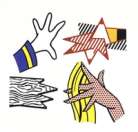
Study Of Hands

Study Of Hands
Signed Print
Roy Lichtenstein
£7,000-£10,500
$14,000-$21,000 Value Indicator
$13,000-$19,000 Value Indicator
¥70,000-¥100,000 Value Indicator
€8,000-€12,000 Value Indicator
$70,000-$110,000 Value Indicator
¥1,450,000-¥2,180,000 Value Indicator
$9,500-$14,000 Value Indicator
There aren't enough data points on this work for a comprehensive result. Please speak to a specialist by making an enquiry.
80 x 83cm, Edition of 100, Planographic print
Auction Results

Track auction value trend
Meaning & Analysis
As the oldest form of mark making, hands have consistently been at the center of artistic practice throughout human history. This particular body part has represented the most elementary means of creation. At the same time, it has also functioned as an important reflection of evolving modes of representation. Hand studies have been employed while exploring the human body from both an artistic and a scientific point of view. Additionally, hands have been used to affirm major advances in cultural trends.
Toying with these sentiments, Roy Lichtenstein’s 1981 Study Of Hands demonstrates every artist’s need for ongoing introspection and creative development. Lichtenstein was notorious for his radically transforming and discontinuous visual language. Therefore, this print also manifests some of the aesthetic stages undergone by the artist himself throughout his career.
Study Of Hands, as its title suggests, showcases four distinct ways to delineate hands. There is a pop hand, a cubist hand, a cartoonish gloved hand, and an expressionist hand. The print asserts the equality of the figurative and the abstract. Moreover, the work also insists on the artist’s freedom to change and combine styles at will. Study Of Hands essentially constitutes a subtle dig aimed at purist notions of ‘high art’.